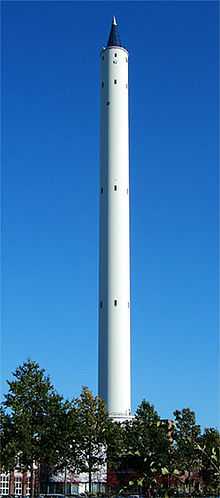University of Bremen
| University of Bremen | |
|---|---|
| Universität Bremen | |
 | |
| Established | 1971 |
| Type | Public |
| Rector | Bernd Scholz-Reiter |
| Academic staff | 1,440; 323 Professors (without assistant professors) |
| Students | 18,000[1] |
| Location | Bremen, Free Hanseatic City of Bremen, Germany |
| Website | www.uni-bremen.de/ |

The University of Bremen (German Universität Bremen) is one of 11 institutions classed as an "Elite university" in Germany, and a university of approximately 23,500 people from 126 countries[citation needed] that are studying, teaching, researching, and working in Bremen. It has become the science center of North West Germany.
The university has most notably reputation in industrial engineering, digital media, physics, mathematics, microbiology, geosciences (particularly marine geosciences) European law and political science.[2][citation needed]
Its commitment was rewarded with the title “Stadt der Wissenschaft 2005” (City of Science of 2005), which science, politics, business and culture won jointly for Bremen and Bremerhaven, by the Foundation for German Science (Stifterverband für die Deutsche Wissenschaft).
Some of the paths that were taken back then, also referred to as the "Bremen model", have since become characteristics of modern universities, such as interdisciplinary, explorative learning, social relevance to practice-oriented project studies which enjoy a high reputation in the academic world as well as in business and industry. Other reform approaches of the former ‘new university’ have proven to be errors such as waiving a mid-level faculty, tripartite representation or too “student-friendly” examination regulations and were given up in Bremen a few years down the track.
Faculties
These are the twelve faculties into which the university is divided:
- Faculty 1: Physics/Electrical Engineering
- Faculty 2: Biology/Chemistry
- Faculty 3: Mathematics/Computer Science
- Faculty 4: Production Engineering - Mechanical Engineering & Process Engineering
- Faculty 5: Geosciences
- Faculty 6: Law
- Faculty 7: Business Studies and Economics
- Faculty 8: Social Sciences
- Faculty 9: Cultural Studies
- Faculty 10: Languages and Literary Studies
- Faculty 11: Human and Health Sciences
- Faculty 12: Pedagogy and Educational Sciences
History

Though Bremen became a university city only recently, higher education in Bremen has a long tradition. The Bremen Latin School was upgraded to "Gymnasium Academicum" in 1584. 1610 it was transformed into "Gymnasium Illustre". Under Napoleonic rule in 1811 the institution of a "French-Bremen University" was considered. In 1971 the University of Bremen opened its doors.
The development of the University of Bremen can be divided up into steps of 10 to 12 years – foundation, restructuring, consolidation and profile building: at the beginning of the 1970s, the University was set up as a “science complex” before the city gates, a city oriented towards trade and seafaring that had no experience with restless academic minds, particularly not with leftist professors. University, business and the public in the region did not move closer together until the 1980s, through the foundation of the natural science and engineering departments, co-operation with the newly founded Alfred Wegener Institute for Polar and Marine Research in Bremerhaven (1980), as well as the development of the co-located technology park (from 1988). Other important factors were the initial success in setting up collaborative research centres and in the acquisition of considerable amounts of external funds. The mathematics professor Jürgen Timm, elected university rector in 1982, was largely responsible for this turnaround.
As a consequence, the University of Bremen improved in research rankings, gained national recognition, and established a number of endowment professorships. Research excellence and the interdisciplinary profile is reflected by numerous research centers and programs funded by the German Research Foundation (DFG). These include currently eight collaborative research centers and the Research Center of Ocean Margins, one of only six national research centers of the DFG.[3]
From 1996 until 2001 the University of Bremen (along with six other universities in Germany) has been participating in a pilot scheme for structural reform of university administration, funded by the Volkswagen Foundation. This project has improved the co-operation and communication between the university's administrations, teaching and research units. By the realization of the "Laptop University" project the University of Bremen has become a leading university in the field of digital media teaching in Germany.
With the turn of the millennium, after an organisational development process of three years in which the university set itself goals for the development of its profile, this trend was continued: in respect of research this includes the promotion of junior scientists in structured graduate program, staff development programs for the great number of early-stage researchers entering the university as junior professors due to the exchange of generations in professorships. In teaching and studies, comprehensive evaluations provide proof of the momentum that the University of Bremen has been holding for a good 35 years now: a new admissions policy with specific admission requirements, the rapid conversion of courses of study to Bachelor’s and Master’s degrees.
See also
| Wikimedia Commons has media related to Universität Bremen. |
- Center of Applied Space Technology and Microgravity
- Fallturm Bremen
- List of colleges and universities
External links
- University of Bremen Website (German) (English)
- International office - Studying in Bremen (English)
- The Collaborative Research Center 597 "Transformations of the State" (German) (English)
- University of Bremen - YouTube
Notes and references
- ↑ According to University press release 3091 from October 20, 2010.
- ↑ University of Bremen. "Rankings and Data on Research".
- ↑ "DFG Research Centres". Deutsche Forschungsgemeinschaft. Retrieved 2010-11-10.
| |||||
Coordinates: 53°06′31″N 8°51′13″E / 53.10861°N 8.85361°E
| ||||||||||||||||||||